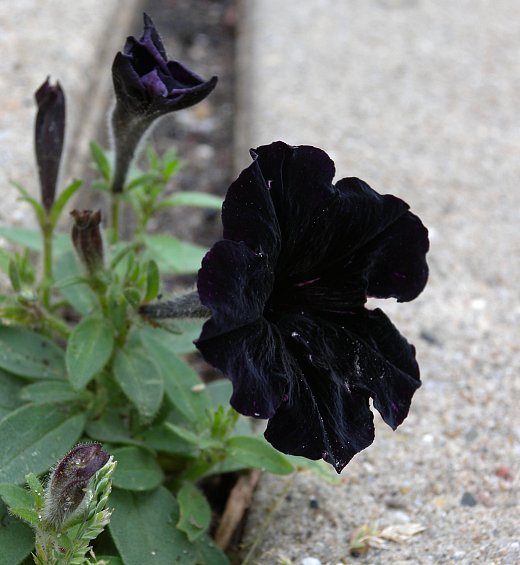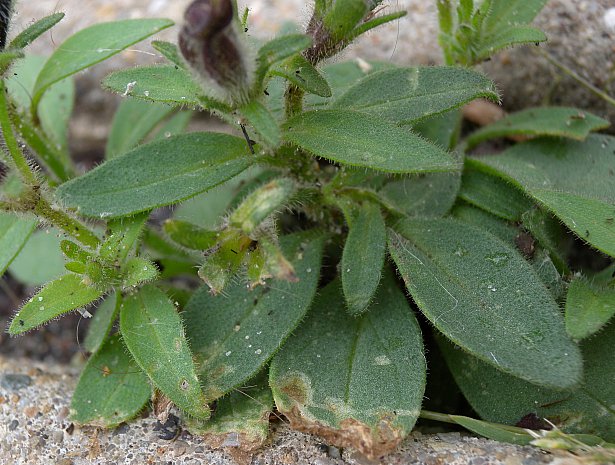
Some bicolored corollas have relatively straight bands of white alternating with another color; these bands originate from the center of the corolla and extend to its outer margin. Other bicolored corollas have one color along the outer margin and another color extending into the interior. Still other corollas have dark-colored veins that contrast with the dominant color of the corolla. The outer margin of the corolla is shallowly 5-lobed or ruffled. The exterior of the corolla (on the other side of the face of the corolla) is glandular-hairy, especially toward its base, while the interior (face) of the corolla is hairless. The deep lobes of the calyx are about 1 cm. (1/3") in length, linear-oblong to elliptic in shape, and entire along their margins. The blooming period occurs during the summer and early autumn for about 1-4 months. Plants that develop from seeds typically bloom for 1-2 months during the late summer and early autumn, while cultivated potted plants bloom earlier and longer. The flowers are usually fragrant to a greater or lesser degree and they are usually diurnal. Individual flowers are short-lived. Afterwards, fertile flowers are replaced by small seed capsules. Individual seed capsules are about ¼" (6 mm.) long, ovoid in shape, and hairless; individual capsules divide into 2 parts above to release numerous tiny seeds. These seeds are about 0.5–0.75 mm. long, subgloboid in shape (globe-shaped, but somewhat flattened), dark-colored, and reticulated. They are small enough to be blown about by wind or they can be carried by currents of water. The root system is fibrous. This plant spreads by reseeding itself.
Cultivation: The preference is full sun, well-drained mesic conditions, and fertile loamy soil. It is easier to cultivate this plant by buying potted plants, although it also possible to germinate the tiny seeds. To extend the season of bloom, withered flowers and developing seed capsules should be removed. This plant can succumb to foliar disease and root rot, particularly when there is a lack of air circulation or poor drainage. Heavy rainfall can cause the corollas of the flowers to fall to the ground. Plants should be watered during hot summer dry spells. Light frost is tolerated, but not severe winter cold.

Range & Habitat: Naturalized plants of the Garden Petunia that have escaped from cultivation are uncommon in Illinois; they have been reported from only a few counties within the state (see Distribution Map). Such naturalized populations rarely persist for very long. The Garden Petunia is a widely cultivated ornamental plant. It is considered a hybrid cross between two South American species, Petunia axillaris and Petunia integrifolia. In Illinois, habitats of naturalized plants include roadsides, areas along railroads, cracks along urban sidewalks and roadside curbs, edges of garden beds, vacant lots, and waste ground. This plant is usually found in highly disturbed areas of cities and towns.
Faunal Associations: The floral visitors of Garden Petunia can vary with the color of the corollas and the fragrance of the flowers. For example, plants with fragrant white flowers tend to attract Sphinx moths (Sphingidae), while plants with gaily colored flowers (pink, magenta, blue, purple, etc.) tend to attract bees and butterflies. Similarly, plants with non-fragrant reddish flowers tend to attract hummingbirds. Both nectar and pollen are available as floral rewards to such visitors. Various insects feed destructively on the foliage, flowers, plant juices, and roots of the Garden Petunia. These species include both the adults and larvae of several leaf beetles, including Epitrix cucumeris (Potato Flea Beetle), Epitrix hirtipennis (Southern Tobacco Flea Beetle), Lema daturaphila (Three-lined Potato Beetle), and Leptinotarsa decemlineata (Colorado Potato Beetle). The polyphagous larvae of a common Agromyzid fly, Liriomyza trifolii, mine the leaves of this plant, while such aphids as Macrosiphum euphorbiae (Potato Aphid) and Nasonovia ribisnigri (Currant-Lettuce Aphid) suck on its sap (Clark et al., 2004; Spencer & Steyskal, 1986; Pepper, 1965; Blackman & Eastop, 2013). The polyphagous larvae of two Noctuid moths, Helicoverpa zea (Corn Earworm) and Trichoplusia ni (Cabbage Looper), sometimes gnaw on the flowers, while the polyphagous larvae of a Noctuid moth, Heliothis virescens (Tobacco Budworm), bore into the flower buds and immature seed capsules of this plant. Because the foliage of Garden Petunia is bitter and mildly toxic, it is rarely bothered by mammalian herbivores.

Photographic Location: A crack along a roadside curb in downtown Urbana, Illinois. The photographed plants escaped from cultivation, but they did not persist for longer than one year.
Comments: A large variety of cultivars have been developed that vary in such characteristics as the size of their flowers, the color(s) of their flowers, their growth habit (erect to sprawling), and disease resistance. The plants that have been photographed have nearly black flowers; this is an unusual color for the Garden Petunia. Nonetheless, several cultivars of Garden Petunia with black flowers have been developed; they include 'Black Velvet,' 'Black Magic,' 'Black Ray,' and 'Black Cat.' The potential pollinators of plants with black flowers are not currently known. Several species of Petunia are known to occur in South America. As a group, they are unusually diverse in the pollinators that their flowers attract. For example, Petunia axillaris has nocturnal white flowers that are fragrant; they attract Sphinx moths. Another South American species, Petunia integrifolia, has diurnal purple flowers that attract primarily bees. Yet another species, Petunia exserta, has non-fragrant red flowers that attract hummingbirds. Other species of Petunia in South America have flowers that are known to attract butterflies or bats. Occasionally, some of these Petunia species are also cultivated in gardens, and some of these non-hybrid species also escape from cultivation. However, none of these species, including the Garden Petunia, are considered invasive in Illinois because they rarely persist.